Application of low-temperature thermochronology on ore deposits preservation framework in South China: a review
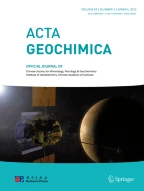
South China can be divided into four metallogenic belts: The Middle-Lower Yangtze Metallogenic Belt (MLYB), Qinzhou-Hangzhou Metallogenic Belt (QHMB), Nanling Metallogenic Belt (NLMB), and Wuyi Metallogenic Belt (WYMB). The major mineralization in the four metallogenic belts is granite-related Cu–Au–Mo and porphyrite Fe-apatite, porphyry Cu (Au), and epithermal Pb–Zn–Ag, hydrothermal Cu–Au–Pb–Zn–Ag, and granite-related skarn-type and quartz-veins W–Sn, respectively. Low-temperature thermochronology, including fission-track and U-Th/He dating, has been widely used to constrain tectonic thermal evolution and ore deposits preservation. Understanding fission-track annealing and He diffusion kinetics in accessory minerals, such as zircon and apatite, is essential for dating and applications. In this study, previous zircon fission-track (ZFT) and apatite fission-track (AFT) ages in South China were collected. The result shows that the ZFT ages are mainly concentrated at 140–90 Ma, and the AFT ages are mainly distributed at 70–40 Ma. The age distribution and inversion temperature–time paths reveal heterogeneous exhumation histories in South China. The MLYB experienced Late Cretaceous-Cenozoic extremely slow exhumation after rapid cooling in the Early Cretaceous. The northern QHMB (i.e. from southern Anhui province to the Hangzhou Bay) had a relatively faster rate of uplifting and denudation than the southern QHMB in the Cretaceous. Subsequently, the northern QHMB rapidly exhumed, while the continuously slow exhumation operated the southern QHMB in the Cenozoic. The southern NLMB had a more rapid cooling rate than the northern NLMB during the Cretaceous time, and the whole NLMB experienced rapid cooling in the Cenozoic, except that the southern Hunan province had the most rapid cooling rate. The WYMB possibly had experienced slow exhumation since the Late Cretaceous. The exhumation thickness of the four metallogenic belts since 90 Ma is approximately calculated as follows: the MLYB ≤ 3.5 km, the northern QHMB concentrated at 3.5–5.5 km, and the southern QHMB usually less than 3.5 km, the NLMB 4.5–6.5 km and the WYMB < 3.5 km. The exhumation thickness of the NLMB is corresponding to the occurrence of the world-class W deposits, which were emplaced into a deeper depth of 1.5–8 km. As such, we infer that the uplifting and denudation processes of the four metallogenic belts have also played an important role in dominated ore deposits.
This is a preview of subscription content, log in via an institution to check access.
Access this article
Subscribe and save
Springer+ Basic
€32.70 /Month
- Get 10 units per month
- Download Article/Chapter or eBook
- 1 Unit = 1 Article or 1 Chapter
- Cancel anytime
Buy Now
Price includes VAT (France)
Instant access to the full article PDF.
Rent this article via DeepDyve
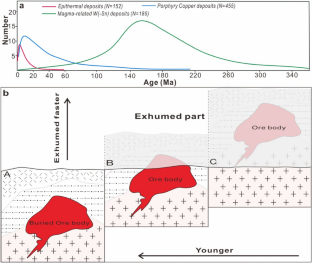
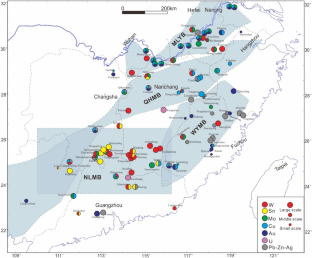

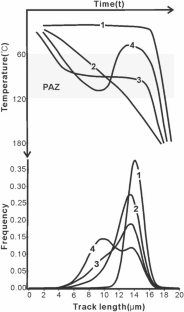

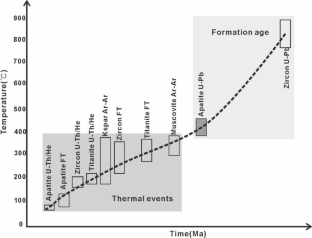
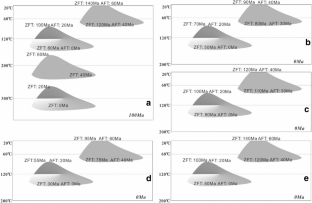
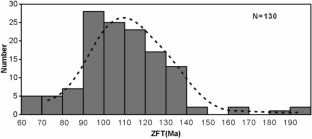
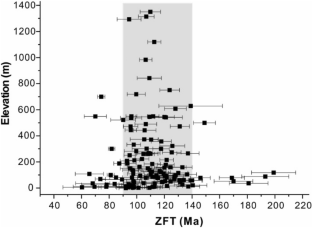
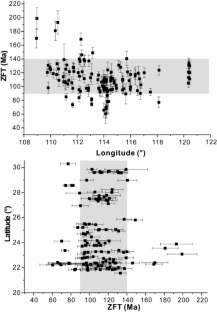
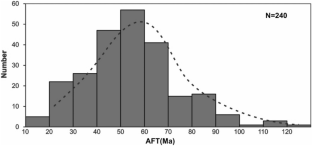
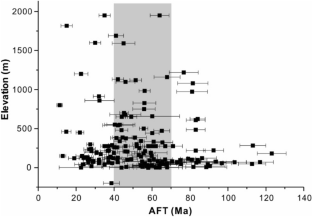
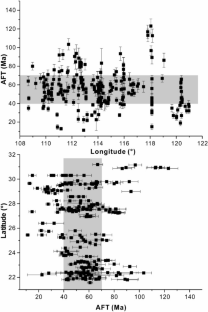
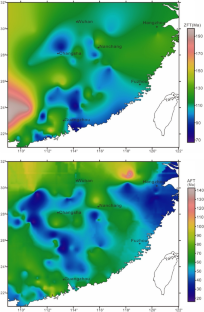
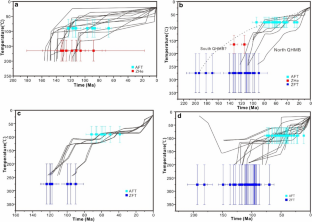
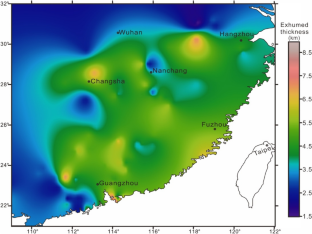

Exhumation history and preservation of the Jiaojia giant gold deposit, Jiaodong Peninsula
Article 11 April 2022
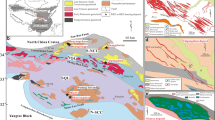
Two episodes of REE mineralization in the Qinling Orogenic Belt, Central China: in-situ U-Th-Pb dating of bastnäsite and monazite
Article 30 March 2019

Exhumation History and Exploration Potential of Gold Deposits in the NE Jiaodong Peninsula, North China: Evidence from Apatite and Zircon Fission Track Thermochronology
Article 22 June 2023
References
- ABGMR (Anhui Bureau of Geology and Mineral Resources) (1987) ABGMR (Anhui Bureau of Geology and Mineral Resources) regional geology of the Anhui Province. Geological Press, Beijing, pp 165–191 (in Chinese with English summary) Google Scholar
- Bai DY, Huang JZ, Meng DB, Ma TQ, Wang XH, Zhang XY, Chen BH (2006) Meso-cenozoic thermochronological analysis of the uplift process of mountains in Southeast Hunan. Acta Geosci Sin 27(6):525–536 (in Chinese with English abstract) Google Scholar
- Bierlein FP, Reynolds N, Arne D, Bargmann C, Mckeag S, Bullen W, Al-Athbah H, McKnight S, Maas R (2016) Petrogenesis of a neoproterozoic magmatic arc hosting porphyry Cu-Au mineralization at Jebel Ohier in the Gebeit Terrane, NE Sudan. Ore Geol Rev 79:133–154 ArticleGoogle Scholar
- Brown RW, Beucher R, Roper S, Persano C, Stuart F, Fitzgerald P (2013) Natural age dispersion arising from the analysis of broken crystals. Part i: theoretical basis and implications for the apatite (U-Th)/He thermochronometer. Geochim Cosmochim Acta 122(3):478–497 ArticleGoogle Scholar
- Cai MH, Zhang WB, Peng ZA, Liu H, Guo TF, Tan ZM, Tang LF (2016) Study on minerogenetic epoch of the Hehuaping tin-polymetallic deposit in southern Hunan. Acta Petrol Sin 32(07):2111–2123 (in Chinese with English abstract) Google Scholar
- Carlson WD, Donelick RA, Ketcham RA (1999) Variability of apatite fission-track annealing kinetics: I. Exp Results Am Miner 84(9):1213–1223 ArticleGoogle Scholar
- Chen CH, Lee CY, Tien JL, Xiang H, Walia M, Lin JW (2020a) Post-orogenic thermal reset of the Pingtan-Dongshan metamorphic belt (SE China): insights from zircon fission track and U-Pb double dating. J Asian Earth Sci 201(3):104512 ArticleGoogle Scholar
- Chen L, Zheng YF, Zhao ZF (2020b) Origin of arc-like magmatism at fossil convergent plate boundaries: Geochemical insights from Mesozoic igneous rocks in the middle to lower Yangtze Valley, South China. Earth Sci Rev 211:103416 ArticleGoogle Scholar
- Chen MH, Dang Y, Zhang ZQ, Chen G, Huang ZZ, Ye YL (2020c) Caledonian tungsten deposits in Dayaoshan area of South China. Miner Depos 39(4):647–685 (in Chinese with English abstract) Google Scholar
- Chen RS, Li JW, Cao K, Qu CY, Li YJ (2013) Zircon U-Pb and molybdenite re-os dating of the Shangfang Tungsten deposit in Northern Fujian Province: implications for regional mineralization. Earth Sci J China Univ Geosci 38(02):289–304 (in Chinese with English abstract) Google Scholar
- Chen WD, Zhang WL, Wang RC, Chu XY, Xiao R, Zhang D, Che XD (2016) A study on the Dushiling tungsten-copper deposit in the Miao’ershan-Yuechengling area, Northern Guangxi, China: implications for variations in the mineralization of multi-aged composite granite plutons. Scientia Sinica Terrae 46(12):1602–1625 Google Scholar
- Cheng SB, Fu JM, Ma LY, Jiang GX, Chen XQ, Lu YY, Tong XR (2013) Indosinian metallogenic activity in Yuechengling-Miaoershan area, northeastern Guangxi: implications from zircon U-Pb ages and Hf isotopic constraint on ore-forming granites in Youmaling and Jiepai deposits. Geol China 40(04):1189–1201 (in Chinese with English abstract) Google Scholar
- Crowley KD, Cameron M, Schaefer RL (1991) Experimental studies of annealing of etched fission tracks in fluorapatite. Geochim Cosmochim Acta 55:1449–1465 ArticleGoogle Scholar
- Dai P, Mao JW, Wu SH, Xie GQ, Luo XH (2018) Multiple dating and tectonic setting of the Early Cretaceous Xianglushan W deposit, Jiangxi Province, South China. Ore Geol Rev 95:1161–1178 ArticleGoogle Scholar
- Deng XD, Li JW, Zhou TF, Zhao XF, Dai RY (2015) In-situ LA-ICPMS trace elements and U-Pb analysis of titanite from the Mesozoic Ruanjiawan W–Cu–Mo skarn deposit, Daye district, China. Ore Geol Rev 65(43):990–1004 ArticleGoogle Scholar
- Dias ANC, Chemale JF, Soares CJ, Soares CJ (2017) A new approach for electron microprobe zircon fission track thermochronology. Chem Geol 459:129–136 ArticleGoogle Scholar
- Donelick RA, O’Sullivan PB, Ketcham RA (2005) Apatite fission-track analysis. Rev Miner Geochem 58:49–94 ArticleGoogle Scholar
- Dong SW, Zhang YQ, Long CX, Yang ZY, Ji Q, Wang T, Hu JM, Chen XH (2008) Jurassic tectonic revolution in China and new interpretation of the “Yanshan Movement.” Acta Geol Sin Engl Ed 82(2):334–347 Google Scholar
- Duan LA, Yang XY, Wang FY, Deng JH, Sun WD (2012) Geochemistry and zircon U-Pb age of ore-bearing porphyry in the Paodaoling gold deposit in Guichi, Middle-Lower Yangtze metallogenic belt. Acta Petrol Sin 28(10):3241–3254 (in Chinese with English abstract) Google Scholar
- Duan Z, Liao SB, Chu PL, Huang WC, Zhu YH, Shu XJ, Li CB (2019) Zircon U-Pb ages of the Neoproterozoic Jiuling complex granitoid in the eastern segment of the Jiangnan orogeny and its tectonic significance. Geol China 38(06):1143–1153 (in Chinese with English abstract) Google Scholar
- Farley KA (2000) Helium diffusion from apatite: general behavior as illustrated by Durango fluorapatite. J Geophs Res 105:2903–2914 ArticleGoogle Scholar
- Farley KA, Wolf RA, Silver LT (1996) The effects of long alpha-stopping distances on (U-Th)/He ages. Geochim Cosmochim Acta 60(21):4223–4229 ArticleGoogle Scholar
- Fleischer RL, Price PB, Walker RL (1975) Nuclear tracks in solids. University of California Press, Berkeley, pp 1–629 BookGoogle Scholar
- Flowers RM, Ketcham RA, Shuster DL, Farley KA (2009) Apatite (U–Th)He thermochronometry using a radiation damage accumulation and annealing model. Geochim Cosmochim Acta 73(8):2347–2365 ArticleGoogle Scholar
- Galbraith RF (1981) On statistical estimation in fission track dating. J Int Assoc Math Geol 16(7):653–669 ArticleGoogle Scholar
- Gallagher K (2012) Transdimensional inverse thermal history modeling for quantitative thermochronology. J Geophys Res Solid Earth 117(B2):53493394 ArticleGoogle Scholar
- Gautheron C, Barbarand J, Ketcham RA, Tassan-Got L, Peter VDB, Pagel M, Pinna-Jamme R, Couffignal F, Fialin M (2013) Chemical influence on α-recoil damage annealing in apatite: implications for (U-Th)/He dating. Chem Geol 351:257–267 ArticleGoogle Scholar
- Gautheron C, Tassan-Got L (2010) A monte carlo approach to diffusion applied to noble gas/helium thermochronology. Chem Geol 273(3–4):212–224 ArticleGoogle Scholar
- Gerin C, Gautheron C, Oliviero E, Bachelet C, Djimbi DM, Seydoux-Guillaume AM, Tassan-Got L, Sarda P, Roques J, Garrido F (2017) Influence of vacancy damage on He diffusion in apatite, investigated at atomic to mineralogical scales. Geochim Cosmochim Acta 197:87–103 ArticleGoogle Scholar
- Ginster U, Reiners PW, Nasdala L, Chanmuang NC (2019) Annealing kinetics of radiation damage in zircon. Geochim Cosmochim Acta 249:225–246 ArticleGoogle Scholar
- Gleadow AJW (2002) Fission track dating methods: principles and techniques, 4th edn. The University of Melbourne, pp 1–83 Google Scholar
- Gleadow AJW, Duddy IR, Green PF, Hegarty KA (1986) Fission track lengths in the apatite annealing zone and the interpretation of mixed ages. Earth Planet Sci Lett 78:245–254 ArticleGoogle Scholar
- Gleadow AJW, Hurford AJ, Quaife RD (1976) Fission track dating of zircon: improved etching techniques. Earth Planet Sci Lett 33:273–276 ArticleGoogle Scholar
- Green PF, Crowhurst PV, Duddy IR, Japsen P, Holford SP (2006) Conflicting (U–Th)/He and fission track ages in apatite: enhanced He retention, not anomalous annealing behaviour. Earth Planet Sci Lett 250(3–4):407–427 ArticleGoogle Scholar
- Guo TL (2004) Meso-Cenozoic Tectono-thermal History of Shiwandashan Basin, South China. Ph.D. Theses, Tongji University (Shanghao), pp. 1–114. (in Chinese with English abstract)
- Hasebe N, Barbarand J, Jarvis K, Carter A (2004) Apatite fission-track chronometry using laser ablation ICP-MS. Chem Geol 207(3–4):135–145 ArticleGoogle Scholar
- Hendriks B, Redfield TF (2005) Apatite fission track and (U-Th)/He data from fennoscandia: an example of underestimation of fission track annealing in apatite. Earth Planet Sci Lett 236(1–2):443–458 ArticleGoogle Scholar
- Ho KS, Chen JC, Lo CH, Zhao HL (2003) 40 Ar– 39 Ar dating and geochemical characteristics of Late Cenozoic basaltic rocks from the Zhejiang-Fujian region, SE China: eruption ages, magma evolution and petrogenesis. Chem Geol 197:287–318 ArticleGoogle Scholar
- Jiang WC, Li H, Evans NJ, Wu JH (2019) Zircon records multiple magmatic-hydrothermal processes at the giant Shizhuyuan W-Sn-Mo-Bi polymetallic deposit, South China. Ore Geol Rev 115:103160 ArticleGoogle Scholar
- Kasuya M, Naeser CW (1988) The effect of α-damage on fission-track annealing in zircon. Nucl Tracks Radiat Meas 14(4):477–480 ArticleGoogle Scholar
- Kesler SE, Wilkinson BH (2006) The role of exhumation in the temporal distribution of ore deposit. Econ Geol 101(5):919–922 ArticleGoogle Scholar
- Ketcham RA (2005) Forward and inverse modeling of low-temperature thermochronometry data. Rev Miner Geochem 58(1):275–314 ArticleGoogle Scholar
- Ketcham RA, Carter A, Donelick RA, Barbarand J, Hurford AJ (2007) Improved modeling of fission-track annealing in apatite. Am Miner 92(5–6):799–810 ArticleGoogle Scholar
- Ketcham RA, Gautheron C, Tassan-Got L (2011) Accounting for long alpha-particle stopping distances in (U–Th–Sm)/He geochronology: refinement of the baseline case. Geochim Cosmochim Acta 75(24):7779–7791 ArticleGoogle Scholar
- Lei DL (2020) Rb-Sr isotopic age of quartz fluid inclusions of Yingshan silver deposit in Tuorong County, Fujian province and its geological significance. Geol Fujian 39(01):1–10 (in Chinese with English abstract) Google Scholar
- Lepvrier C, Maluski H, Tich VV, Leyreloup A, Thi PT, Vuong VN (2004) The Early Triassic Indosinian orogeny in Vietnam (Truong Son Belt and Kontum Massif); implications for the geodynamic evolution of Indochina. Tectonophysics 393(1–4):87–118 ArticleGoogle Scholar
- Li CH, Jiang YH, Xing GF, Guo KY, Li C, Yu MG, Zhao P, Wang Z (2015) Two periods of skarn mineralization in Baizhangyan W-Mo deposit, Southern Anhui province, Southeast China: evidence from zircon U-Pb and molybdenite Re–Os and sulfur isotope data. Resour Geol 65(3):193–209 ArticleGoogle Scholar
- Li HQ, Wang DH, Lu YF, Yang HM, Xu JX, Zhang JQ (2007) Rock-forming and ore-forming ages of the Yanbei Porphyry tin deposit in Jiangxi Province and their geological significance. Acta Geosci Sin 05:456–461 (in Chinese with English abstract) Google Scholar
- Li J, Shi W, Zhang YQ, Dong SW (2016) Thermal evolution of the Hengshan extensional dome in central South China and its tectonic implications: new insights into low-angle detachment formation. Gondwana Res 35:425–441 ArticleGoogle Scholar
- Li SB (2017) Meo-Cenozoic tectonothermal pattern of the South China Block: constraints from the fission track analysis. Ph.D. Theses, Sun Yat-Sen University (Guangzhou), pp. 1–161. (in Chinese with English abstract)
- Li SG (2004) Exhumation mechanism of the ultrahigh-pressure metamorphic rocks in Dabie mountains and continental collision process between the North and South China blocks. Earth Sci Front 03:63–70 Google Scholar
- Li SM, Xiao YP, Wang Q, Zhang XH, Yang L, Wang YL, Zhang CM (2013) Re-Os dating of molybdenite from the Tongcun Porphyry molybdenum deposit in Western Zhejiang province and its geological implications. Geol Explor 49(01):50–57 (in Chinese with English abstract) Google Scholar
- Li XM, Wang YJ, Tan KX, Peng TP (2005) Meso-Cenozoic uplift and denudation of Yunkai block: constraints by fission track study. Chin Sci Bull 06:577–583 (in Chinese with English abstract) Google Scholar
- Li QW, Zhao JH (2020) Amalgamation between the Yangtze and Cathaysia blocks in South China: evidence from the ophiolite geochemistry. Precambrian Res 350:105893 ArticleGoogle Scholar
- Li Y, Yuan F, Jowitt SM, Wang FY, Li XL, Deng YF, Wang YY, Zhou TF (2020) Molybdenite Re–Os, titanite and garnet U-Pb dating of the Magushan skarn Cu–Mo deposit, Xuancheng district, Middle-Lower Yangtze river metallogenic belt. Geosci Front 12(3):101116 ArticleGoogle Scholar
- Li ZX, Li XH, Wartho JA, Clark C, Li WX, Zhang CL, Bao CM (2010) Magmatic and metamorphic events during the early Paleozoic Wuyi-Yunkai orogeny, southeastern South China: new age constraints and pressure-temperature conditions. Geol Soc Am Bull 122(5–6):772–793 ArticleGoogle Scholar
- Liu GX, Deng YF, Yuan F, Chen XJ, Yang B (2021) Rb–Sr dating and S-Sr–Nd isotopic constraints on the genesis of the Hehuashan Pb–Zn deposit in the Middle-Lower Yangtze River Metallogenic belt, China. Solid Earth Sci. https://doi.org/10.1016/J.SESCI.2021.04.003ArticleGoogle Scholar
- Liu SB, Liu ZQ, Wang CH, Wang DH, Zhao Z, Hu ZH (2017) Geochemical characteristics of REEs and trace elements and Sm-Nd dating of scheelite from the Zhuxi giant tungsten deposit in northeast Jiangxi. Earth Sci Front 24(05):17–30 (in Chinese with English abstract) Google Scholar
- Liu SS, Weber U, Glasmacher UA, Xu ZQ, Wagner GA (2009) Fission track analysis and thermotectonic history of the main borehole of the Chinese continental scientific drilling project. Tectonophysics 475(2):318–326 ArticleGoogle Scholar
- Liu WH, Zhang J, Li WT, Sun T, Jiang MR, Wang J, Wu JY, Chen CJ (2012) Metallogenic depth, post-mineralization uplift and denudation of porphyry-like type Iron deposits in Ningwu, Luzong basins: evidences from apatite fission track. Earth Sci 37(05):966–980 (in Chinese with English abstract) Google Scholar
- Liu X, Fan HR, Evans NJ, Batt GE, McInnes IA, Yang KF, Qin KZ (2014) Cooling and exhumation of the mid-Jurassic porphyry copper systems in Dexing City, SE China: insights from geo-and thermochronology. Miner Depos 49(7):809–819 ArticleGoogle Scholar
- Mao JW, Cheng YB, Chen MH, Franco P (2013a) Major types and time–space distribution of Mesozoic ore deposits in South China and their geodynamic settings. Miner Depos 48:267–294 ArticleGoogle Scholar
- Mao JW, Xie GQ, Guo CL, Yuan SD, Cheng YB, Chen YC (2008) Spatial-temporal distribution of Mesozoic ore deposits in South China and their metallogenic settings. Geol J China Univ 14(04):510–526 (in Chinese with English abstract) Google Scholar
- Mao JW, Xiong BK, Liu J, Pirajno F, Cheng YB, Ye HS, Song SW, Dai P (2017) Molybdenite Re/Os dating, zircon U-Pb age and geochemistry of granitoids in the Yangchuling porphyry W-Mo deposit (Jiangnan tungsten ore belt), China: implications for petrogenesis, mineralization and geodynamic setting. Lithos 286:35–52 ArticleGoogle Scholar
- Mao ZH, Cheng YB, Liu JJ, Yuan SD, Wu SH, Xiang XK, Luo XH (2013b) Geology and molybdenite Re–Os age of the Dahutang granite-related veinlets-disseminated tungsten ore field in the Jiangxin Province, China. Ore Geol Rev 53(3):422–433 ArticleGoogle Scholar
- Márton I, Moritz R, Spikings R (2010) Application of low-temperature thermochronology to hydrothermal ore deposits: formation, preservation and exhumation of epithermal gold systems from the eastern rhodopes, bulgaria. Tectonophysics 483(3–4):240–254 ArticleGoogle Scholar
- McDannell KT, Issler DR, O’Sullivan PB (2019) Radiation-enhanced fission track annealing revisited and consequences for apatite thermochronometry. Geochim Cosmochim Acta 252:213–239 ArticleGoogle Scholar
- Min K, Gao JF, Qi YQ, Liu Y, Yang SG (2020) Application of LA-ICP-MS/FT in the perservation of ore deposits—case studies of the Dexing Copper deposit and Yinshan Pb-Zn deposit, Northeastern Jiangxi Province. Geotecton Metallog 44(01):80–91 (in Chinese with English abstract) Google Scholar
- Nancy DN, Charles WN (1984) Fission-track dating. Dev Palaeontol Stratigr 7:87–100 ArticleGoogle Scholar
- Nasdala L, Hanchar JM, Kronz A, Whitehouse MJ (2005) Long-term stability of alpha particle damage in natural zircon. Chem Geol 220(1):83–103 ArticleGoogle Scholar
- Nie LQ, Zhou TF, Fan Y, Zhang QM, Zhang M, Wang LH (2016) LA-ICPMS U-Pb zircon age and molybdenite Re-Os dating of Donggushan, the first tungsten deposit found in the Luzong orefield, Middle-Lower Yangtze River Valley Metallogenic Belt. Acta Petrol Sin 32(02):303–318 (in Chinese with English abstract) Google Scholar
- Peng HQ, Jia BH, Tang XS (2004) Uplift process of Mufushan and thermochronology of Wangxiang granites in northeastern Hunan province. Bull Geol Sci Technol 01:11–15 (in Chinese with English abstract) Google Scholar
- Pickering J, Matthews W, Enkelmann E, Guest B, Koblinger BM (2020) Laser ablation (U–Th)/He dating of detrital apatite. Chem Geol 548:119683 ArticleGoogle Scholar
- Price PB, Walker RM (1963) Fossil tracks of charged particles in mica and the age of minerals. J Geophys Res 68(16):4847–4862 ArticleGoogle Scholar
- Price PB, Walker RL (1962) Observation of charged-particle tracks insolids. J Appl Phys 33:3400–3406 ArticleGoogle Scholar
- Shen CB, Mei LF, Min K, Jonckheere R, Ratschbacher L, Yang Z, Peng L, Liu ZQ (2012) Multi-chronometric dating of the Huarong granitoids from the middle Yangtze Craton: implications for the tectonic evolution of eastern China. J Asian Earth Sci 52:73–87 ArticleGoogle Scholar
- Shi HC, Shi XY, Yang XQ, Jiang HY (2013) The exhumation process of Mufushan granite in Jiangnan uplift since Cenozoic: evidence from low-temperature thermochronology. Chin J Geophys 56(6):1945–1957 (in Chinese with English abstract) Google Scholar
- Su QW, Mao JW, Wu SH, Zhang ZC (2017) Geochronology and geochemistry of the granitoids and ore—forming age in the Xiaoyao tungsten polymetallic skarn deposit in the Jiangnan Massif tungsten belt, China: implications for their petrogenesis, geodynamic setting, and mineralization. Lithos 296–299:365–381 Google Scholar
- Sun P, Guo PY, Niu YL (2021) Eastern China continental lithosphere thinning is a consequence of paleo-Pacific plate subduction: a review and new perspectives. Earth Sci Rev 218:103680 ArticleGoogle Scholar
- Sun T (2006) A new map showing the distribution of granites in South China and its explanatory notes. Geol Bull China 25(3):332–335 (in Chinese with English abstract) Google Scholar
- Tagami T, Carter A, Furford AJ (1996) Natural long-term annealing of the zircon fission-track system in Vienna Basin deep borehole samples: constraints upon the partial annealing zone and closure temperature. Chem Geol 130:147–157 ArticleGoogle Scholar
- Tagami T, Ito H, Nishimura S (1990) Thermal annealing characteristics of spontaneous fission tracks in zircon. Chem Geol Isot Geosci 80(2):159–169 ArticleGoogle Scholar
- Tamer MT, Ketcham RA (2020) The along-track etching structure of fission tracks in apatite: observation and implications. Chem Geol 553:119809 ArticleGoogle Scholar
- Tang C, Yang X, Cao J (2019) Genesis of the Shangjinshan W-Mo polymetallic deposit in the Eastern Jiangnan tungsten belt: evidences from geochemistry, geochronology and zircon Hf isotope analyses. Ore Geol Rev 115:103172 ArticleGoogle Scholar
- Tang DLK, Seward D, Wilson CJN, Sewell RJ, Carter A, Paul BT (2014a) Thermotectonic history of SE China since the Late Mesozoic: insights from detailed thermochronological studies of Hong Kong. J Geol Soc Lond 171:591–604 ArticleGoogle Scholar
- Tang SL, Yan DP, Qiu L, Gao JF, Wang CL (2014b) Partitioning of the Cretaceous Pan-Yangtze basin in the central South China block by exhumation of the Xuefeng Mountains during a transition from extensional to compressional tectonics. Gondwana Res 25:1644–1659 ArticleGoogle Scholar
- Tao N, Li ZX, Danišík M, Evans NJ, Batt GE, Li WX, Pang CJ, Jourdan F, Xu YG, Liu YP (2017) Thermochronological record of Middle-Late Jurassic magmatic reheating to Eocene rift-related rapid cooling in the SE South China block. Gondwana Res 46:191–203 ArticleGoogle Scholar
- Tao N, Li ZX, Danišík M, Evans NJ, Li RX, Pang CJ, Li WX, Jourdon F, Yu Q, Liu LP, Batt GE, Xu YG (2019) Post-250 Ma thermal evolution of the central Cathaysia Block (SE China) in response to flat-slab subduction at the proto-Western Pacific margin. Gondwana Res 75:1–15 ArticleGoogle Scholar
- Vermeesch P (2017) Statistics for LA-ICP-MS based fission track dating. Chem Geol 456:19–27 ArticleGoogle Scholar
- Wan GL (2013a) Hunan Qianlishan Granite constraints on mineralization. Ph.D. Theses, China University of Geosciences (Beijing), pp 3–122 (in Chinese with English abstract)
- Wan TF (2013b) A new Asian tectonic unit map. Geol China 40(05):1351–1365 (in Chinese with English abstract) Google Scholar
- Wang F, Chen HL, Batt GE, Lin XB, Gong JF, Gong GH, Meng LF, Yang SF, Jourdon F (2015) Tectonothermal history of the NE Jiangshan-Shaoxing suture zone: evidence from 40 Ar/ 39 Ar and fission-track thermochronology in the Chencai region. Precambrain Res 264:192–203 ArticleGoogle Scholar
- Wang GG, Ni P, Zhao KD, Wang XL, Liu JQ, Jiang SY, Chen Y (2012) Petrogenesis of the middle Jurassic Yinshan volcanic-intrusive complex, SE China: implications for tectonic evolution and Cu-Au mineralization. Lithos 150:135–154 ArticleGoogle Scholar
- Wang XY, Suo YH, Li SZ, Cao XZ, Li XY, Zhou J, Wang PC, Jin C (2020a) Cenozoic uplift history and its dynamic mechanism along the eastern continental margin of South China. Acta Petrol Sin 36(6):1803–1820 (in Chinese with English abstract) ArticleGoogle Scholar
- Wang Y, Deng JF, Wang JY, Xiong LP (2001) Terrestrial heat flow pattern and thermo-tectonic domains in the continental area of China. J Grad Sch Acad Sin 18(01):51–58 (in Chinese with English abstract) Google Scholar
- Wang YF, Yang MH, Zhang LG, Lu SS, Yang ZF, Qiu XF, Dong ZP (2017) Metallogenic epoch and ore-forming material source of the Tongshanling Pb-Zn polymetallic deposit in southeastern Hu’nan Province: evidence from Sm-ND isochron age and Pb isotope. Geol Bull China 36(05):875–884 (in Chinese with English abstract) Google Scholar
- Wang YN, Zhang J, Zhang BH, Zhao H (2018) Cenozoic exhumation history of South China: a case study from the Xuefeng Mt. Range J Asian Earth Sci 151:173–189 ArticleGoogle Scholar
- Wang YS, Bai Q, Tian ZQ, Lu SM, Li JS, Zhou YZ, Du H, Jiang C (2021) Exhumation history of late Mesozoic intrusions in the Tongling-Xuancheng area of the Lower Yangtze region, eastern China: evidence from zircon (U–Th)/He and apatite fission track thermochronology. Ore Geol Rev 135:104220 ArticleGoogle Scholar
- Wang Y, Wang YJ, Li SB, Seagren E, Zhang YZ, Zhang PZ, Qian X (2020b) Exhumation and landscape evolution in eastern South China since the Cretaceous: new insights from fission-track thermochronology. J Asian Earth Sci 191:104239 ArticleGoogle Scholar
- Wolfe MR, Stockli DF (2010) Zircon (U–Th)He thermochronometry in the KTB drill hole, germany, and its implications for bulk he diffusion kinetics in zircon. Earth Planet Sci Lett 295:69–82 ArticleGoogle Scholar
- Wu ZL (2021) Metallogenic age of Jinkeng gold polymetallic deposit in Shaowu City, Fujian Province. Miner Depos 40(01):19–33 (in Chinese with English abstract) Google Scholar
- Wyborn LAI, Heinrich CA, Jaques AL (1994) Australian proterozoic mineral systems: essential ingredients and mappable criteria. In: Hallenstein PC (ed) Australian mining looks north-the challenges and choices, vol 5. Australian Institute of Mining and Metallurgy Publication Series, pp 109–115 Google Scholar
- Xi WW, Chen SZ, Zhu XT (2020) Research and discussion on the metallogenic epochs of the Xiashan Pb-Zn deposit in Zhenghe County, Fujian Province. Geol China 47(02):440–449 (in Chinese with English abstract) Google Scholar
- Xia B, Liu LW, Li J, Lin XG, Xu LF, Lin LZ (2010) Metallogenic geochronology of Yuanzhuding Cu-Mo deposit in western Guangdong-eastern Guangxi metallogenic belt and its geological significance. Miner Depos 29(03):395–404 (in Chinese with English abstract) Google Scholar
- Xiao F, Fan FP, Xing GF, Jiang SY (2021) Ore genesis of Qingyunshan Cu-Au deposit in the Dehua-Youxi area of Fujian Province, southeastern China: constraints from U-Pb and Re-Os geochronology, fluid inclusions, and H-O-S-Pb isotope data. Ore Geol Rev 132:104006 ArticleGoogle Scholar
- Xiao QL, Zhou TF, Hollings P, Wang SW, Liu J, Yang QG, Yuan F (2020) Mineral and whole-rock chemistry of the Chating porphyry Cu–Au deposit related intrusions in the Middle-Lower Yangtze River Belt, Eastern China: implications for magma evolution and mineralization. Lithos 380–381:105881 Google Scholar
- Xiao X, Zhou TF, Yuan F, Fan Y, Zhang DY, Liu DZ, Huang WP, Chen XF (2017) The geochronology of the Qingyang Gaojiabang tungsten-molybdenum deposit and its geological significance, Anhui Province, East China. Acta Petrol Sin 33(03):859–872 (in Chinese with English abstract) Google Scholar
- Xie JC, Tang DW, Xia DM, Wang Y, Li QZ, Yang XY, Sun WD (2019) Geochronological and geochemical constraints on the formation of Chizhou Cu-Mo polymetallic deposits, middle and lower Yangtze metallogenic belt, eastern China. Ore Geol Rev 109:322–347 ArticleGoogle Scholar
- Xu YM, Jiang SY, Zhu JX (2021) Factors controlling the formation of large porphyry Cu deposits: a case study from the Jiurui ore district of Middle-Lower Yangtze River Metallogenic Belt using in situ zircon and apatite chemistry from syn-mineralization intrusions. Ore Geol Rev 2021:104082 ArticleGoogle Scholar
- Yamada R, Tagami T, Nishimura S, Ito H (1995) Annealing kinetics of fission tracks in zircon: an experimental study. Chem Geol 122(1–4):249–258 ArticleGoogle Scholar
- Yi Y, Carter A, Xia B, Lin G, Brichau S, Hu XQ (2009) A fission-track and (U–Th)/He thermochronometric study of the northern margin of the South China Sea: an example of a complex passive margin. Tectonophysics 474(3–4):584–594 ArticleGoogle Scholar
- Yang MG, Wu FJ, Shong ZR, Lu SJ (2015) North Jiangxi: A geological window of South China. Acta Geol Sin 89(02):222–233 ((in Chinese with English abstract)) Google Scholar
- Yao JM, Hua RM, Qu WJ, Qi HW, Lin JF, Du AD (2007) Re-Os isotope dating of molybdenites in the Huangshaping Pb-Zn-W-Mo polymetallic deposit, Hunan Province, South China and its geological significance. Sci China Ser D Earth Sci 50:519–526 ArticleGoogle Scholar
- Ye TZ, Lv ZC, Pang ZS et al (2014) Metallogenic prognosis theories and methods in exploration areas: Pandect. Geologic Publishing House, Beijing, pp 70–76 (in Chinese) Google Scholar
- Yin A, Harrison TM (2000) Geologic evolution of the Himalayan-Tibetan Orogen. Annu Rev Earth Planet Sci 28:211–280 ArticleGoogle Scholar
- Yuan SD, Mao JW, Zhao PL, Yuan YB (2018) Geochronology and petrogenesis of the Qibaoshan Cu-polymetallic deposit, northeastern Hunan Province: implications for the metal source and metallogenic evolution of the intracontinental Qinhang Cu-polymetallic belt, South China. Lithos 302–303:519–534 ArticleGoogle Scholar
- Yuan SD, Zhang DL, Shuang Y, Du AD, Qu WJ (2012) Re-Os dating of molybdenite from the Xintianling giant W-molybdenum deposit in southern Hunan Province, China and its geological implications. Acta Petrol Sin 28(01):27–38 (in Chinese with English abstract) Google Scholar
- Yuan YS, Ma YS, Hu SB, Guo TL, Fu XY (2006) Present-day geothermal characteristics in South China. Chin J Geophys 49(4):1118–1126 (in Chinese with English abstract) ArticleGoogle Scholar
- Zhai YS (1999) On the metallogenic system. Earth Sci Front 01:14–28 (in Chinese with English abstract) Google Scholar
- Zhang D, Wu GG, Di YJ, Wang CM, Yao JM, Zhang YY, Lv LJ, Yuan Y, Shi JJ (2012) Geochronology of diagenesis and mineralization of the Luoyang iron deposit in Zhangping city, Fujian Province and its geological significance. Earth Sci J China Univ Geosci 37:1217–1231 (in Chinese with English abstract) Google Scholar
- Zhang DQ, She HQ, Li DX, Feng CY (2003) The porphyry-epithermal metallogenic system in the Zijinshan. Acta Geol Sin 77:253–261 (in Chinese with English abstract) Google Scholar
- Zhang J, Liu XX, Zeng Z, Li W, Peng LL, Hu HB, Cheng JW, Lu KX (2021) Age constraints on the genesis of the Changkeng tungsten deposit, Nanling region, South China. Ore Geol Rev 134:104134 ArticleGoogle Scholar
- Zhang JJ, Chen ZH, Wang DH, Chen ZY, Liu SB, Wang CH (2008) Geological characteristics and metallogenic epoch of the Xingluokeng tungsten deposit, Fujian Province. Geotecton Metallog 01:92–97 (in Chinese with English abstract) Google Scholar
- Zhang QQ, Gao JF, Tang YW, Min K (2020) In-situ LA-ICP-MS U-Pb dating and trace element analyses of Wolframites from the Xingluokeng Tungsten deposit in Fujian Province, China. Bull Miner Petrol Geochem 39(06):1278–1291+1311. (in Chinese with English abstract)
- Zhang WL, Hua RM, Wang RC, Chen PR, Li HM (2006) New dating of the Dajishan granite and related tungsten mineralization in Southern Jiangxi. Acta Geol Sin 07:956–962 (in Chinese with English abstract) Google Scholar
- Zhao PL, Yuan SD, Mao JW, Santosh M, Li C, Hou KJ (2016) Geochronological and petrogeochemical constraints on the skarn deposits in Tongshanling ore district, southern Hunan Province: implications for Jurassic Cu and W metallogenic events in South China. Ore Geol Rev 78:120–137 ArticleGoogle Scholar
- Zhao XY, Zhong H, Mao W, Bai ZJ, Xue K (2020) Molybdenite Re-Os dating and LA-ICP-MS trace element study of sulfide minerals from the Zijinshan high-sulfidation epithermal Cu-Au deposit, Fujian Province, China. Ore Geol Rev 118:103363 ArticleGoogle Scholar
- Zheng Y, Yu XQ, Yuan WM, De EW, Jiang GB, Zhu DL, Wang C, Jia YY (2011) Exhumation history of the Huangshan granite pluton, southern Anhui Province: new insights from fission-track analysis. Sci China Earth Sci 54(4):528–539 ArticleGoogle Scholar
- Zhong J, Chen YJ, Pirajno F, Chen J, Li J, Qi JP, Li N (2014) Geology, geochronology, fluid inclusion and H-O isotope geochemistry of the Luoboling porphyry Cu–Mo deposit, Zijinshan Orefield, Fujian Province, China. Ore Geol Rev 57:61–77 ArticleGoogle Scholar
- Zhou TF, Wang SW, Fan Y, Yuan F, Zhang DY, White NC (2015) A review of the intracontinental porphyry deposits in the Middle-Lower Yangtze River Valley metallogenic belt, Eastern China. Ore Geol Rev 65:433–456 ArticleGoogle Scholar
- Zhou XM, Sun T, Shen WZ, Shu LS, Niu YL (2006) Petrogenesis of Mesozoic granitoids and volcanic rocks in South China: a response to tectonic evolution. Episodes 29(1):26–33 ArticleGoogle Scholar
- Zuo LY, Hou ZQ, Meng XJ, Yang ZM, Song YC, Li Z (2010) SHRIMP U-Pb zircon geochronology of the ore-bearing rock in the Lengshuikeng porphyry type Ag-Pb-Zn deposit. Geol China 37(05):1450–1456 (in Chinese with English abstract) Google Scholar
- Zuo XR (2015) Active-passive margin transition in the Cathaysia Block: thermochronological and kinematic constraints. HKU Theses Online (HKUTO), pp 1–256
Acknowledgements
This manuscript is supported by the National Science Fund for Distinguished Young Scholars (42025301) and Natural Science Foundation of China (41673057). We are grateful to Dr. Liu Qian of the University of Hong Kong for several constructive comments and polishing our language.
Author information
Authors and Affiliations
- State Key Laboratory of Ore Deposit Geochemistry, Institute of Geochemistry, Chinese Academy of Sciences, Guiyang, 550081, China Kang Min & Jian-Feng Gao
- University of Chinese Academy of Sciences, Beijing, 100049, China Kang Min & Jian-Feng Gao
- Kang Min
You can also search for this author in PubMed Google Scholar
You can also search for this author in PubMed Google Scholar
Contributions
All authors contributed to the conception and design study. Data collection and analysis: MK; Writing, original draft preparation: MK; Writing, review and editing: JFG. All authors read and approved the final manuscript.
Corresponding author
Ethics declarations
Conflict of interest
We declare no conflicts of interest in this study. The manuscript has not been submitted to more than one journal for simultaneous consideration.
Supplementary Information
Below is the link to the electronic supplementary material.
Supplementary file1 (XLSX 37 KB)
Rights and permissions
About this article
Cite this article
Min, K., Gao, JF. Application of low-temperature thermochronology on ore deposits preservation framework in South China: a review. Acta Geochim 41, 165–184 (2022). https://doi.org/10.1007/s11631-021-00506-x
- Received : 31 August 2021
- Revised : 18 October 2021
- Accepted : 19 October 2021
- Published : 27 January 2022
- Issue Date : April 2022
- DOI : https://doi.org/10.1007/s11631-021-00506-x
Share this article
Anyone you share the following link with will be able to read this content:
Get shareable link
Sorry, a shareable link is not currently available for this article.
Copy to clipboard
Provided by the Springer Nature SharedIt content-sharing initiative
Keywords
- Low-temperature thermochronology
- Fission-track annealing and He diffusion kinetics
- South China
- Exhumation history
- Deposits preservation




















